Green Protect Home Fly Traps and Crawling Insect Traps
Green Protect fly traps, crawling insect traps and replants are part of our Pest, Disease and Weed Control section.
The Green Protect range is perfect for monitoring the levels of crawling and flying insects in your home and garden. They offer an eco-friendly and pesticide-free method of detection and control by using attractants and glues rather than pesticides.
When the weather worsens and temperatures drop, insects can find your nice, warm home, an attractive proposition. The range of Green Protect insect traps and repellents work to deter or trap creepy crawlies.
Regular inspection of traps works to alert you to a potential problem. Early notification allows you to take evasive action and avoid the problem-pest becoming a long-term problem.
The traps work by using a long-lasting, non-drying glue, paired with either an attractive colour or pheromone that moths, flies, gnats (and many other flying insects) are attracted to land on, trapping them in place.
The repellents are perfect for keeping problem insects away from you, while you’re in the garden. They help to limit the number of annoying flying insects in your living spaces. They also let you monitor levels so you can easily understand if you have an issue and need to take any remedial action.
The Green Protect range work to attract and trap or repel flying and crawling insects in a variety of situations, like:
- Hanging visual attraction traps
- Surface mounted visual attraction (plus discreet) traps
- Pheromone attraction traps
- Pot plant insect Traps
Different Types of Fly Traps and Crawling Insect Trap
Different types of traps work to attract (and trap) flying or crawling pests, alerting you to their presence and allowing you to take preventative measures.
Traps are available for indoor and outside pests. Hanging and surface-mounted fly traps work via visible and aroma/pheromone attraction. Different traps either have a pheromone or use colour or 3D luminous colours printed on the card to attract flying insects. When pests land, the long-lasting glue strips trap them in place. This stops them annoying you or worse – landing on food items or biting/bothering you/laying eggs etc.
Pheromone traps attract and trap different types of moth. This works to save your clothes from being damaged and food infestations from moths, or other flying or crawling insects, like weevils.
The Green Protect range includes visible and discreet products. The Fly Discreet product features an innovative, patented 3D pattern with fluorescent colour and lasting glue, which is highly attractive to flies. They even offer life-like Fruit Fly traps in the form of apples. These traps are great for leaving in or near fruit bowls to capture bothersome fruit flies.
The following points highlight a variety of garden and household pests. We talk about the best ways to attract and trap them, so you’re alerted as soon as possible.
Different Types of Indoor Pests
About Flies
Flies are often found in and around waste bins and sources of food. This can be inside, attracted by your kitchen bin or an outside bin. Flies are a year-round problem. They survive and over-winter in our warm homes and can still be highly annoying. Thanks to the Green Protect range of fly traps you can find a visible or discreet way to lower or eliminate the number of flies in your home.
To trap flies in your home, use the following Green Protect products:
- Fly Tower Fly Trap – hanging or surface mounted visual attraction with glue trap.
- Fly Spiral Fly Trap – low cost traditional hanging sticky fly trap.
- Discrete Fly Trap – surface mounted visual attractant with glue trap.
- Window Fly Trap – Removable in-window visual attraction – place where flies are a problem and remove/replace.
Brown spots on white surfaces and around windows
Flies like to rest on light, reflective surfaces, like around windows. When they rest, they defecate or regurgitate on the surface. This leaves those noticeable dark spots around where they’ve rested. If you’re not sure what I mean, go and look at a window now – it’s highly likely you’ll see exactly what I mean. The more flies you have in your house, the more noticeable the issue will be. The Window Fly Trap can really help you where you have this issue.
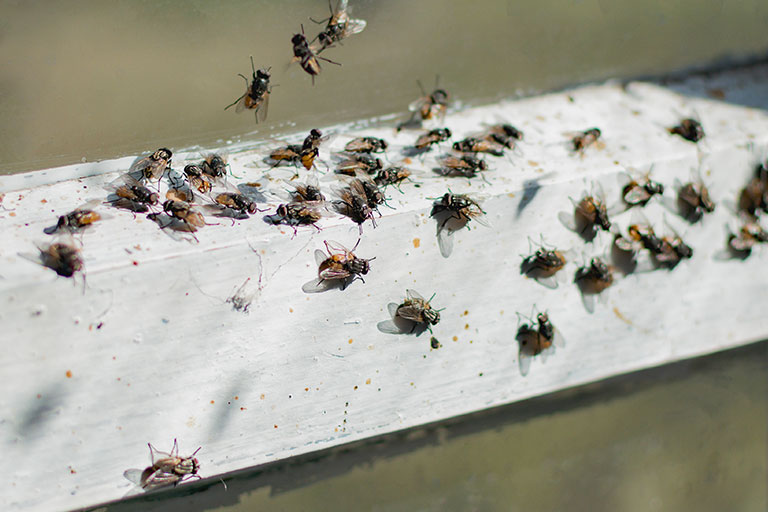
We all know they (flies) are more abundant (and annoying) in the warmer months, when they’re more common. Flies are attracted into our homes by a variety of aromas, usually coming from our kitchens and bins. Once they appear, they seem to spend the rest of their lives annoying us. Either consistently banging in to the window trying to get out or occupying any room with a light on in the evening or worse: landing on our food.
Flies go through a 4-stage lifecycle; from egg to larvae and pupae to adult. Weather and temperature depending, this cycle often takes a week to complete.
Flies carry various harmful bacteria, including salmonella and E.coli, contaminating any surface they land on. This includes foods, which can make you ill, should you consume it.
Bluebottle’s deliberately lay their eggs in food – both in raw and cooked dishes. And the common house fly choses to lay their eggs in rotten food, meaning that when it lands on other types of food it is only to feed.
How To Get Rid Of Flies In Your Home
When your Green Protect Fly Traps detect the presence of flies, you may need to implement certain measures to prevent them.
To prevent flies in your home you can use the below simple, eco-friendly methods:
- Clean the problem area and continue to keep your home as clean as possible.
- Remove food sources, ensure that liquids and food are removed from the area of detection and cover food in open areas.
- Empty waste daily and clean up any spilt liquids and food.
- Use Green Protect Fly Traps (Tower/Spiral/Discreet).
- Use flyscreens on open windows and doors when it is not possible to keep them closed.
- Keep an eye on your fly traps for signs of fly problems.
- If the problem persists, contact a professional pest controller.
About Fruit Flies
Fruit flies are a common insect pest in and around the home. They are especially attracted to decomposing fruit and vegetables, as well as empty bottles and food containers. An adult fruit fly can lay up to 25-eggs a day. Eggs hatch out after a short while, and the larvae are ready to seek a food source and begin to feed. They then pupate and soon hatch out as adults. Temperature depending, the entire cycle takes around 6-10 days.
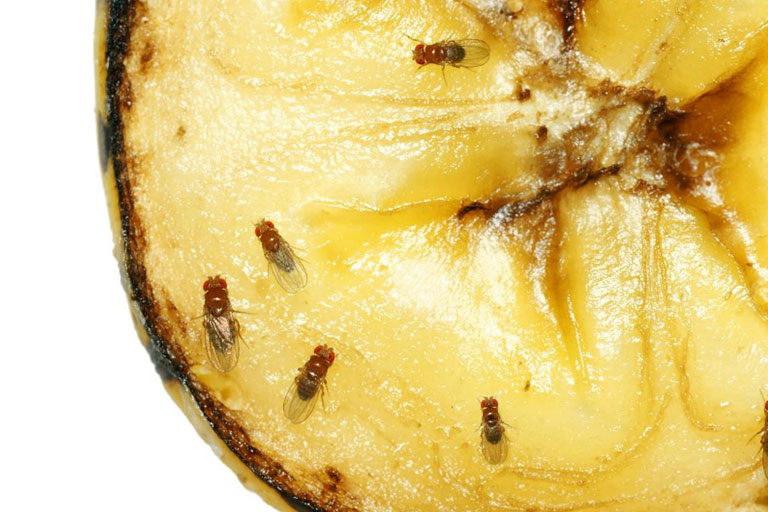
How To Get Rid Of Fruit Flies In Your Home
Green Protect Fruit Fly Traps are an effective, innovative way to prevent fruit fly infestations in your home.
Directions for use:
- Carefully open the top of the apple-style trap.
- Pour the entire contents of the attractant bottle into the trap.
- Gently press the trap’s lid in place, leaving it slightly open.
- Regularly check the trap. In the event of a catch, locate the problem and implement control measures.
Fruit Fly Prevention and Control
When your Green Protect Fruit Fly Trap detects the presence of the pest, you may need to implement preventative measures to remove them.
To remove this pest from your home in an eco-friendly manner, use the following method:
- Clean and maintain cleanliness of the problem area with a mild cleaning/disinfectant.
- Remove access to food sources and ensure that liquids and foods are removed or sealed.
- Empty your waste daily and clean up any spilt food or liquids.
- Dispose of food containing fruit fly larvae and eggs.
The Green Protect Fly Traps can be used in the home all year round. Keep it where you keep your fruit and vegetables and other open, loose foods. Fruit flies find the traps irresistible and quickly reveal any fruit flies. Regularly checking the trap will give you the best chance to avoid any future fruit fly infestations.
About Green Protect Pot Plant Fly Traps
We all love potted plants in our homes. They add a splash of colour and give us a focal point for that moment of quiet reflection. The problem is, insect pests also like the warm, dark, moist conditions of the soil. The fact we keep our homes warm, is attractive to pests and allows them to survive (in the pots) and proliferate over the colder months.
Fungus Gnats can become particularly annoying. They lay their eggs in the pots and the larvae feed on your plants roots, damaging them. Getting a plant back to full health can take time. The adults can be found in warm, moist bathroom windows and walls, annoyingly buzzing around you at every opportunity.
Using Green Protect Pot Plant Fly Traps can help you to detect and avoid the beginnings of an problem turning into a real issue. The pot plant fly catcher traps can be use all year round, but are particularly useful over winter and into the early in the growing season, before the insect population begins to build up on your potted plants.
The potted plant fly traps work inside your pots and the Green Protect Yellow Fly Traps work in other places, where you can hang them anywhere around your home, where you have an issue.
The innovative design of these fly traps is based on research findings that showed a number of insects are attracted to specific colour wavelengths – stimulating an insects response. Due to the high-tech non-drying adhesive, insects are caught quickly. The yellow tone of these fly traps is especially attractive to common pests like:
- Fungus Gnats
- Whitefly
- Aphids
- Fruit Flies
About Fungus Gnats
Fungus Gnats are small dark coloured flies, around 3mm in size, and are often found in indoor plants, particularly where humidity is high.
The larvae of Fungus Gnats cause damage to houseplants as they feed and damage the plant’s roots resulting in the plant turning yellow and stunting growth. Although the adults live for only 1 week on average, they lay up to 300 eggs which take 4-6 days for the larvae to emerge.
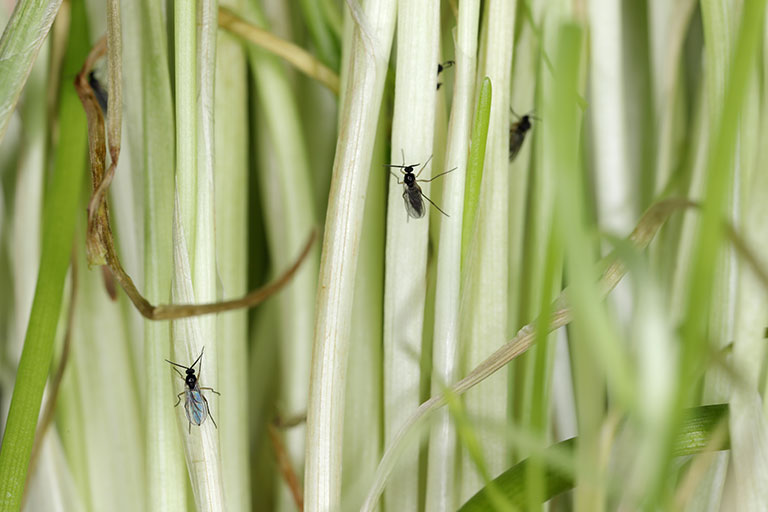
How To Get Rid Of Fungus Gnats In Your Home
When your Green Protect Pot Plant Fly Traps have detected the presence of plant-feeding insects, you may need to implement measures to remove them.
To remove Fungus Gnats from your home you can use the below simple, eco-friendly methods:
- Keep soil dry by not over watering as they thrive in damp conditions.
- Add sand to help keep the soil dry and reduce larvae growth.
- Position a Green Protect Fruit Fly Trap near infected plant.
- Position a Green Protect Pot Plant Insect Trap in all potted plants.
- Keep an eye on your fly traps for this pest.
About Whitefly
The Whitefly has a white, wax-like, powder layer on top of its body and is around 2mm in size. They can be found on a range of different plants and if you touch the plant, they will suddenly disperse.
Both flies and the nymphs (larvae/young whitefly) can be found underneath the leaves as these small sucking insects take the nutrients from the plant and transmit disease. Worst case infestations can result in the plant drying out and losing its leaves.
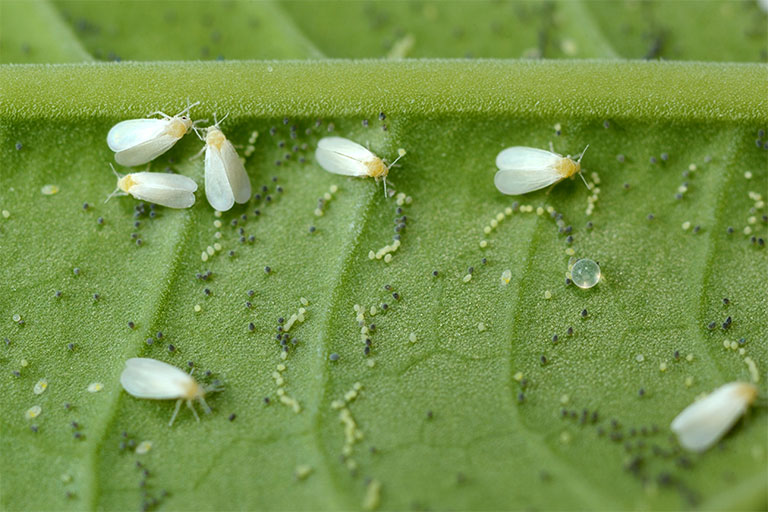
The whitefly and it’s nymphs secrete honeydew, making the leaves of the plant sticky. In bad cases, this honeydew can cover the plant in black mould.
It is possible for female whitefly to lay 200-400 eggs each season, which falls in late Spring. Whitefly are notorious for building up a resistance to synthetic chemical pesticides therefore eco-friendly solutions are often the most effective solution.
How To Get Rid Of Whitefly In Your Home
When your Green Protect Pot Plant Fly Traps have detected the presence of plant-feeding insects, you may need to implement measures to remove them.
To remove whitefly from your home you can use the below simple, eco-friendly methods:
- Use a small hand vacuum to remove pests from under the leaves.
- Remove the extremely infected branches or leaves using garden cutters.
- Wash your plant with a soap / water solution.
- Position a Green Protect Pot Plant Insect Trap in all potted plants.
- Keep an eye on your fly traps for signs of this pest.
About Aphids
Aphids can have many different coloured appearances including yellow, green, black, grey and white or pink and brown. They are around 2mm in size and can be found on plants inside and outside.
Aphids can be winged and wingless. Usually the first generation to emerge from the over-wintered eggs are wingless. It’s not until after several generations that there can be a lack of space on the host plant. This triggers the birth of a generation of winged aphids, which can go on to migrate to other hosts.
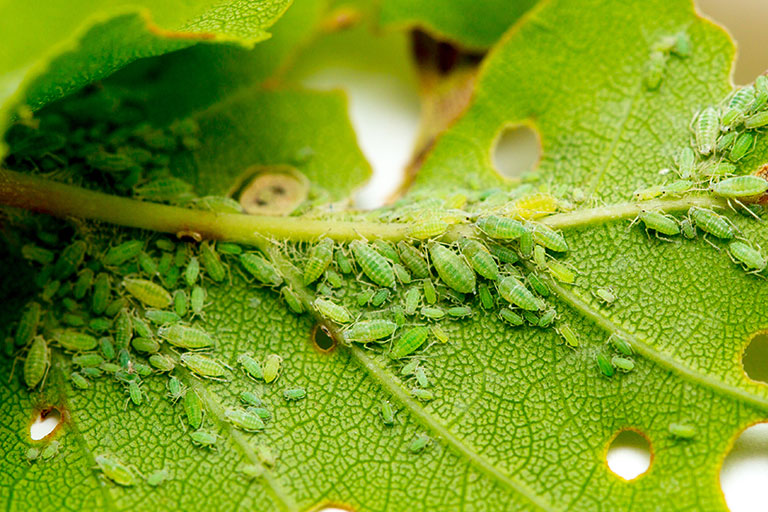
Aphids are a problem as they suck the sap from the leaves, causing them to wither. Like Whitefly, Aphids secrete honeydew which makes the leaves of the plant sticky and potentially covered in black mould.
Aphids are often found on new, young plants where there are new leaves or flowers growing as they contain the most nutrients. Due to disease transmission, Aphids can cause serious damage as they make the plant’s leaves turn yellow and curl whilst growth is stunted.
How To Get Rid Of Aphids In Your Home
When your Green Protect Pot Plant Fly Traps have detected the presence of plant-feeding insects, you may need to implement measures to remove them.
To remove Aphids from your home you can use the below simple, eco-friendly methods:
- Wearing gloves, remove the Aphids by hand and dispatch between your fingers.
- Using a garden hose, spray the infected plants with water. Avoid using a high pressure that jet that can damage the plant.
- Cut the plant back to reduce the chance of large colonies growing.
- Spray the plant with a soap / water solution.
- Position a Green Protect Pot Plant Insect Trap in all potted plants.
- Keep an eye on all your Green Protect fly traps for signs.
Pheromone Traps for Moths
About Clothes Moths (Indoor Pest)
Do moths eat clothes?
No, but their larvae do.
Many of us leave our clothes hung up and when we get them out, notice there are little holes in the textile. Questions like: “Do moths eat clothes?” spring to mind, as we wondering where the holes have come from. The answer is: yes! It’s mostly the larvae of the Clothes Moth, which is why early detection is crucial.
If you catch an adult in a Green Protect Clothes Moth Trap, it’s a great indicator that you need to clean and hoover the nooks and crannies in your wardrobes and drawers.
Clothes moth eggs are not easy to detect as they are very fragile and often hidden in cracks and crevices. The pest’s larvae is the main culprit that causes the damage (holes) in textile products. They feed on ingredients primarily found in natural fabrics but they also need protein. They get this by seeking out impurities, such as grease stains, blood and sweat in worn textiles.
Clothes Moth larvae dislike light, so they remain in areas where it is dark and easy to hide.
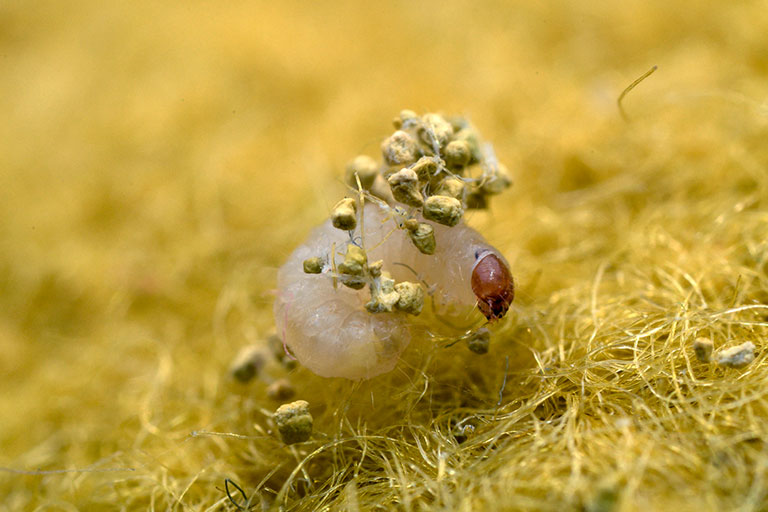
Indications of clothes moth larvae include webs, larvae casings and droppings.
When the larvae has finished eating it begins to develop into an adult moth. The adult clothes moth does not cause any damage to textile items,. However, they are the source of the larvae and therefore the Green Protect Clothes Moth Trap targets this stage of the life cycle.
How To Get Rid of Clothes Moths In Your Home
When your Green Protect Clothes Moth Trap has detected the presence of clothes moths, you may need to implement measures to remove them. To remove the pest from your home you can use the below simple, eco-friendly methods. Cleaning is key to prevent clothes moths as their fragile eggs are often destroyed by cleaning:
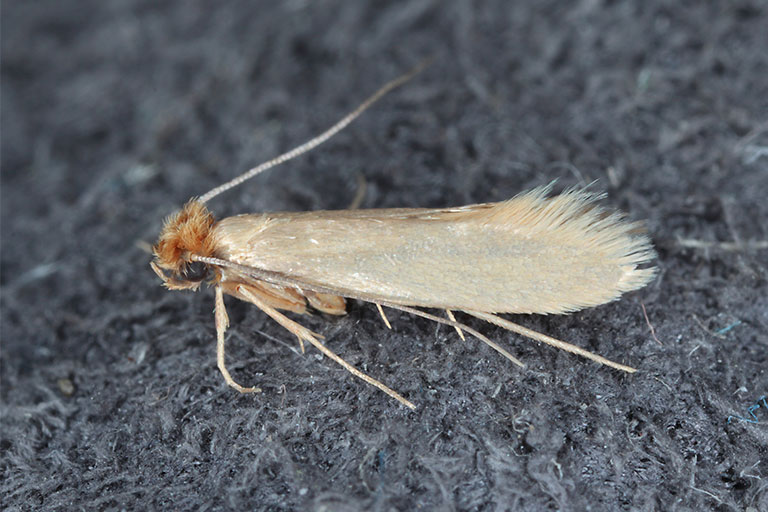
Within clothing
- Remove the contents of wardrobes/chests of drawers.
- Thorough vacuuming and cleaning of the furniture – remember the cracks and crevices! If it is difficult to access the cracks, crevices and corners with the vacuum cleaner, a soft, long haired brush is recommended.
- Wash clothing at a minimum of 55°C as clothes moths can withstand high temperatures. Washing at high temperatures and subsequent drying, kills moths, larvae and eggs. Clothes that cannot withstand high temperatures may be frozen to a min. -18°C for 2-3 days. This removes all stages of the pest’s lifecycle.
- Chemical cleaning by dry cleaners can also remove all stages of the pest’s lifecycle.
- Clean items such as bags, baskets, suitcases etc., as if they are stored with clothes inside, they may contain hidden larvae and eggs
Within rugs and furniture (wardrobes and chest of drawers)
- Thorough vacuuming and cleaning of the rugs and furniture.
- If below -10°C, rugs and furniture can be placed outdoors for 48 hours. Clothes moths can tolerate frost for short periods, but alternating temperatures kills them quickly.
- Ensure all furniture contains a Green Protect Clothes Moth Trap to ensure you can continue monitoring Clothes Moth activity.
How To Prevent Clothes Moths
The following procedure gives you ideas on how to prevent clothes moths, but also using Green Protect Cedar Wood Moth Rings works to deter the adult Clothes Moth, as they don’t like the aroma the wooden rings give off. These long-lasting, eco-friendly, deterrents last around six months. What’s even better is, you can give them a quick, light-sanding after this time to reinvigorate them, offering even longer useful service.
- Thoroughly vacuum and clean regularly including inside furniture and turn over rugs when vacuuming.
- Rugs and wall hangings should be beaten regularly outside with beater.
- Position an Green Protect Clothes Moth Trap in areas where clothing is being stored and inspect regularly.
- Store clothing that is not regularly used in air-tight plastic or paper bags.
- When storing furs and fur-covered items, we advise you to contact a fur dealer.
- Always have an Green Protect Clothes Moths Trap in your wardrobe, drawers, under the couch, etc. The trap will indicate when control measures are required.
About Flour Moths (Indoor Pest)
The flour moth is also known as the meal moth and is commonly found where you would store flour, cereals and other dry food goods. The meal moth is attracted to dried fruit, nuts and cereals. The moths are often brought into domestic homes via food shopping.
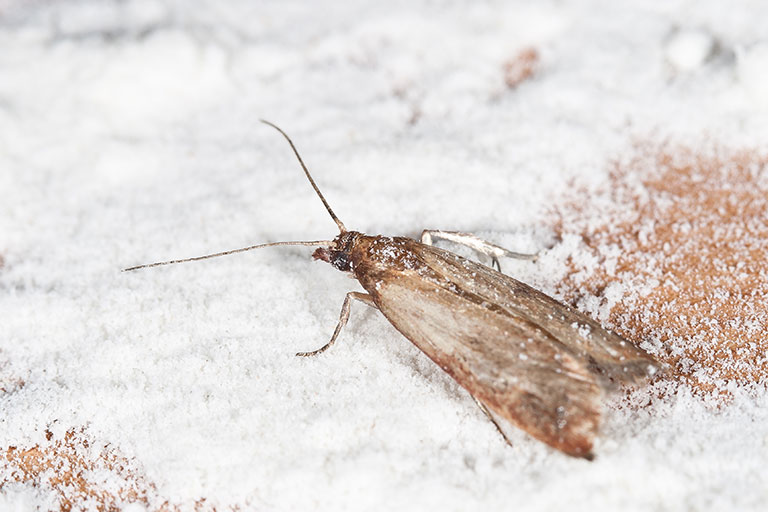
If not detected early, this pest can soon become a larger problem. A single moth can produce up to 400 eggs from per mating season. The larvae commonly hatch within 4 days and immediately begins to feed and spin a sticky thread like web. When the larvae stage is complete the pest will begin to pupate and try to find a crack or crevice close by in which to pupate, undisturbed.
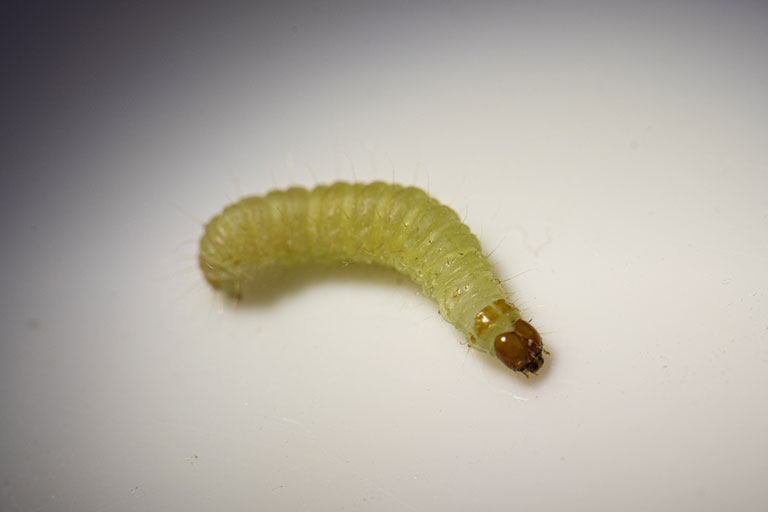
Prevention and control
When your Green Protect Flour Moth Trap has detected the presence of flour moths, you may need to implement measures to remove them.
To remove pest from your home you can use the below simple, eco-friendly methods:
- Empty the contents of kitchen cabinets and drawers.
- Thorough vacuuming and cleaning of the cupboards , not forgetting the cracks and crevices.
- Check all stored food and remove any that shows evidence of infection/infestation.
Garden tip: Use airtight containers to store foods, such as:
- Flour and corn products
- Rice
- Pasta
- Nuts and dried fruit
Different Types of Indoor Crawling Insects
About Silverfish (Lepisma saccharina)
Silverfish can be recognised by their silvery appearance and the two antennae on the front of their bodies. They can grow up to 1cm long and can live for up to 5 years. They’re a nocturnal pest and are most active at night. Silverfish thrive in moist, warm environments and are usually found in bathrooms, utility rooms, kitchens and lofts/attics. They favour cracks and crevices to hide in and lay their eggs.
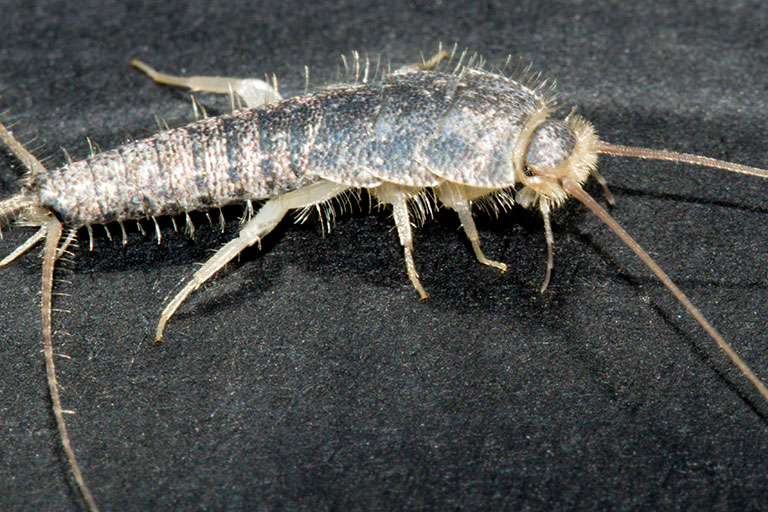
About Long-tailed Silverfish (Ctenolepisma longicaudata)
The long-tailed silverfish is also known as the grey silverfish. This type of silverfish are approximately 12 – 18mm in size. They can be recognised by their grey and brown colour tones as they appear less silvery than the standard silverfish with a hairier body. The long-tailed silverfish are also nocturnal and thrive in moist, warm environments including the bathroom, utility rooms, kitchens and lofts/attics.
Silverfish are harmless to humans, but their droppings can destroy books, old papers, wallpaper, carpets and clothes. They also love to make homes in your unsealed pasta, oat and cereal packets, which is a massive reason why most people don’t want them in their home and want to get rid of them quickly.
How To Get Rid Of Silverfish
When your Green Protect Silverfish Trap has detected the presence of silverfish, you may need to implement measures to remove them.
To remove silverfish from your home you can use the below simple, eco-friendly methods:
- Keep targeted room ventilated and reduce humidity as much as possible. This could also be done with the use of a de-humidifier.
- Thorough and frequent vacuuming and cleaning helps reduce the presence of silverfish – remember the cracks and crevices.
- As water accumulates in cracks and crevices, it provides favourable conditions for silverfish. Ensure you dry any surfaces after cleaning.
- If the problem persists, it would be advised to contact a professional pest controller.
About Woodlice
The woodlouse is easily recognised by its armour-like appearance and the two small antennae on the top of its body.
They’re highly dependent on moisture and dehydrate rapidly if the humidity of their habitat reduces, which is why woodlice are often found in dark and damp places. Woodlice use their antennae to seek out moisture, water and other woodlice.
As woodlice typically do not live indoors, finding them your home is an indication that the humidity could be too high. It can also alert you to an issue with damp.
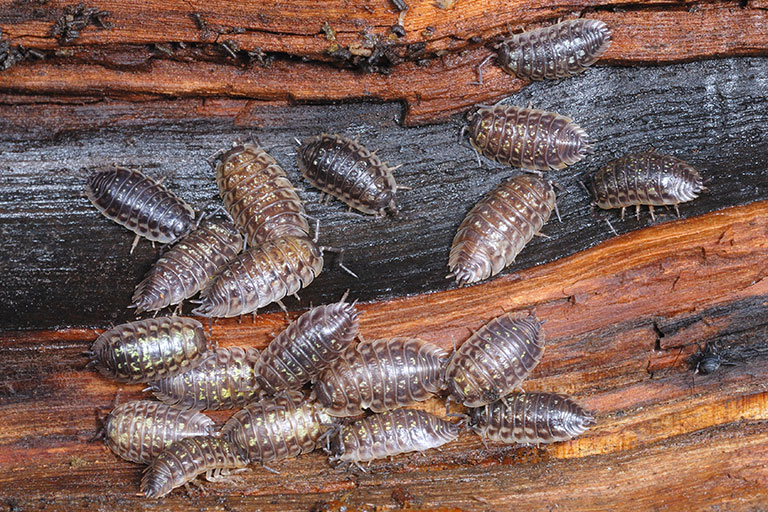
How To Get Rid Of Woodlice
When your Green Protect Crawling Insect Trap detects the presence of woodlice, you may need to implement measures to remove them.
To remove woodlice from your home you can use the below simple, eco-friendly methods:
- Keep the targeted room ventilated and reduce humidity as much as possible. This could also be done with the use of a dehumidifier.
- Thorough and frequent vacuuming and cleaning helps reduce the presence of woodlice – remember the cracks and crevices.
- As water accumulates in cracks and crevices, it provides favourable conditions for woodlice. Ensure you dry any surfaces after cleaning.
- Remove of garden waste and rotting leaves from near your home as woodlice thrive in this environment.
- If the problem persists, it would be advised to contact a professional pest controller.
About Cockroaches
Cockroaches are used in horror films to give the impression of grime and uncleanliness. Seeing them scuttling across a dirty kitchen floor denotes a dirty place. They send a shiver up your spine and make you instantly feel grimy and dirty. They are used to purvey an instant feeling of filth.
Cockroaches thrive in warm and humid conditions. The most common species are the German Cockroach, the Oriental Cockroach and the Brown-Banded Cockroach.
People often wonder: “can Cockroaches fly”? Well, they can, or more accurately, glide, over short distances. However, they prefer to run as they look for a warm, dark, humid, spot with easy access to food and water. You’re not likely to catch one in your fly traps, but don’t be surprised if you do.
They’re nocturnal, fast moving pests – and not something you want to feel running over your exposed foot when you’re getting the milk out of the fridge on a dark evening.
Cockroaches spread viruses and bacteria and can cause infectious disease. They also secrete an unpleasant odour to attract other cockroaches. In extreme cases this may cause allergic reactions in sensitive people.
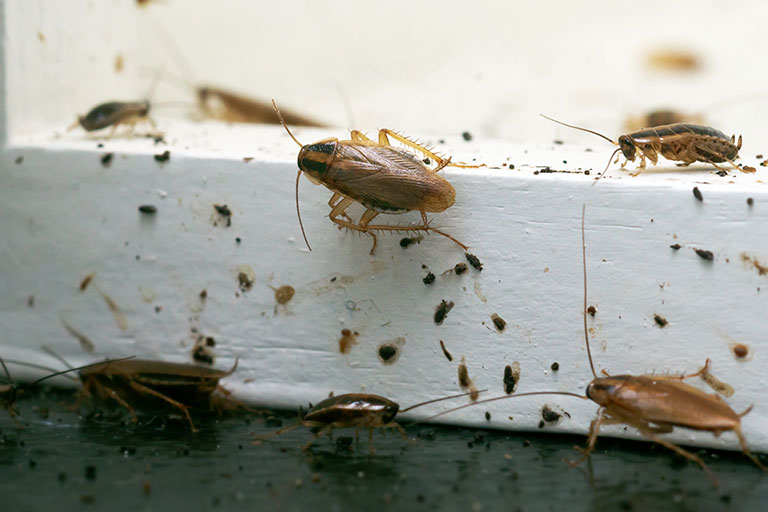
Cockroaches seek heat, water and easy access to food. This is why they’re usually found in difficult to clean areas, in kitchens and bathrooms. They love household and commercial electrical appliances that generate heat, such as:
- Ovens
- Stoves
- Refrigerators
- Dishwashers
How To Get Rid Of Cockroaches:
When your Green Protect Crawling Insect Trap detects the presence of cockroaches, you may need to implement measures to remove them.
To remove cockroaches from your home you can use the below simple, eco-friendly methods:
- Thorough and frequent vacuuming and cleaning helps reduce the presence of cockroaches (remember the cracks and crevices).
- As water accumulates in cracks and crevices, it provides favourable conditions for cockroaches. Ensure you dry any surfaces after cleaning.
- Remove food sources and ensure that liquids and foods are removed from the area of treatment.
- Empty the waste daily and clean up any spilt liquids and foods.
- Close off any potential access points such as cracks and crevices.
- If the problem persists – contact a professional pest controller.




